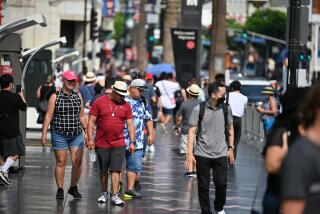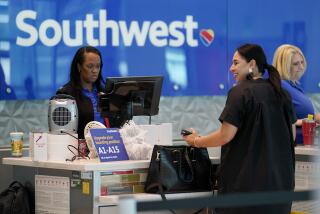U.S. Travel Business on Road to Recovery
- Share via
The nation’s travel industry could be en route to its best year since the Sept. 11 terrorist attacks.
Hotels are filling up. People are packing planes. Even Europeans are back, lured to the states by the cheap dollar.
“In the post-9/11 world, everyone thought the sky was falling,” said Carl Winston, director of the Hospitality and Tourism Management program at San Diego State. “But in reality, the long-term health of this industry rises and falls with the economy.”
In that case, the economy must be improving. The Travel Industry Assn. of America will say in its annual forecast Friday that people will spend $592.6 billion on travel in the U.S. this year, up 6.9% from 2003. In fact, according to the forecast, for the first time since 2000, virtually every segment of the industry is seeing gains.
That a recovery is underway was evident Monday when American Express Co., the fourth-largest U.S. credit card issuer, attributed a third-quarter profit hike to customers spending more on travel. Net income was up 14% to $879 million, or 69 cents a share, from $770 million, or 59 cents, in the year-earlier period.
What’s more, Beverly Hills-based Hilton Hotels Corp. said on Monday that its third-quarter earnings jumped 79% to $61 million, or 16 cents a share, compared with $34 million, or 9 cents, in the same period a year earlier. It said revenue increased 9% to $1.03 billion.
Hilton shares fell 8 cents to $19.53 on a generally down day on the New York Stock Exchange. American Express shares, which also trade on the NYSE, fell 58 cents to $51.15.
The earnings gain for Hilton was attributed to “vibrant summer travel demand” that could be felt broadly across the nation. The company said Hilton-owned hotels in New York and Boston showed particularly good results, in part because that’s where the Republicans and Democrats held their conventions. But Honolulu, Washington, San Diego, Portland, Ore., and Anchorage also proved to be strong markets. Hilton said that even San Francisco, hurt by a slump in the tech industry, showed signs of improvement.
“A company like Hilton is particularly well-situated for this recovery because it has so many large gateway properties in the major cities and tourist resorts,” Winston said.
And Hilton expects more good times ahead, in part because it isn’t as dependent on bargain-hunting leisure travelers as in recent years. Having more business travelers makes it easier to raise room rates, said Marc Grossman, the chain’s senior vice president of corporate affairs. The company is seeing a turnaround in the convention business, he said, which will “really help next year because we own a lot of these big 1,000-room hotels that cater to groups and conventions.”
It all seems to be generally good news for the travel industry, a $78-billion business in California.
Tourism is only part of the story. According to the travel association, 143.7 million work-related trips will be taken this year, up 4% from last year. That will be below 2000 levels, but will represent a healthy gain, said Suzanne Cook, the association’s senior vice president of research.
Not all segments are performing equally well. Airlines may be selling more tickets, but many carriers are losing money because of high fuel expenses and lingering labor issues.
Domestic airline passenger volume is up almost 5% year to date, to 363 million passengers, according to the travel association. Still, that’s down 11% from four years ago.
On the other hand, international air travel, both to and from the U.S., has soared, helped by the low value of the dollar, Cook said. Passenger volume has risen 15.4% to 44 million, slightly above 2000 levels.
As for hotels, there’s no doubt they’re having their best year since 2000, said Bobby Bowers, a spokesman for Smith Travel Research in Hendersonville, Tenn. One measure of hotel financial performance -- revenue per available room -- is up 7.5% through the first nine months of this year nationally after having declined in the first nine months of each of the last three years.
One reason is that there aren’t enough new rooms to meet the growing demand. Even with mounting evidence of a recovery, lodging companies have been hesitant to build, Winston said, and it takes several years to find a location and erect a hotel.
In Los Angeles, the revenue per available room at major hotels rose 14.8% to an average of $91.59 in the first eight months of the year, said Bruce Baltin of PKF Consulting. That average was still below the $95.23 collected in the first eight months of 2000.
Winston said that for all the gains being racked up by the travel industry this year, they’re not enough, although travelers might not agree.
“What this recovery really needs to go from good to great,” he said, “are some strong price increases.”
More to Read
Inside the business of entertainment
The Wide Shot brings you news, analysis and insights on everything from streaming wars to production — and what it all means for the future.
You may occasionally receive promotional content from the Los Angeles Times.











